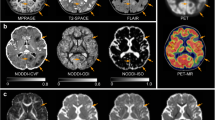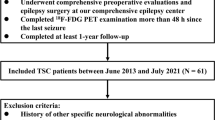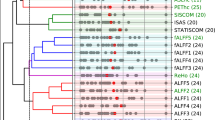Abstract
Purpose
We aimed to evaluate whether the heterogeneity of tuber imaging features, evaluated on the structural imaging and apparent diffusion coefficient (ADC) map, can facilitate detecting epileptogenic tubers before surgery in tuberous sclerosis complex (TSC) patients.
Methods
Twenty-three consecutive patients, who underwent tuber resection at our institute, were retrospectively selected. A total of 125 tubers (39 epileptogenic, 86 non-epileptogenic) were used for the analysis. Tuber heterogeneity was evaluated, using a 5-point visual scale and standard deviation of ADC values (ADCsd). A 5-point visual scale reflected the degree of T1/T2 prolongation, presence of internal cystic degeneration, and their spatial distribution within the tuber. These results were statistically compared between epileptogenic and non-epileptogenic groups, and their performance in predicting the epileptogenicity was also evaluated by receiver operating characteristic (ROC) analysis.
Results
A 5-point visual scale demonstrated that more heterogeneous tubers were significantly more epileptogenic (p < 0.001). Multiplicity of internal cystic degeneration moderately correlated with epileptogenicity (p < 0.03) based on the comparison between class 4 and class 5 tubers. ADCsd was significantly higher in epileptogenic tubers (p < 0.001). ROC curves revealed that a 5-point visual scale demonstrated higher area under the curve (AUC) value than ADCsd (0.75 and 0.72, respectively).
Conclusion
Tuber heterogeneity may help identify the epileptogenic tubers in presurgical TSC patients. Visual assessment and standard deviation of ADC value, which are easier to implement in clinical use, may be a useful tool predicting epileptogenic tubers, improving presurgical clinical management for TSC patients with intractable epilepsy.



Similar content being viewed by others
Data Availability
The datasets generated and/or analyzed during the current study are available from the corresponding author on reasonable request.
References
Prather P, de Vries PJ (2004) Behavioral and cognitive aspects of tuberous sclerosis complex. J Child Neurol 19:666–674. https://doi.org/10.1177/08830738040190090601
Jones AC, Shyamsundar MM, Thomas MW et al (1999) Comprehensive mutation analysis of TSC1 and TSC2-and phenotypic correlations in 150 families with tuberous sclerosis. Am J Hum Genet 64:1305–1315. https://doi.org/10.1086/302381
Chandra PS, Salamon N, Huang J et al (2006) FDG-PET/MRI coregistration and diffusion-tensor imaging distinguish epileptogenic tubers and cortex in patients with tuberous sclerosis complex: a preliminary report. Epilepsia 47:1543–1549. https://doi.org/10.1111/j.1528-1167.2006.00627.x
Wu JY, Sutherling WW, Koh S et al (2006) Magnetic source imaging localizes epileptogenic zone in children with tuberous sclerosis complex. Neurology 66:1270–1272. https://doi.org/10.1212/01.wnl.0000208412.59491.9b
Yogi A, Hirata Y, Karavaeva E et al (2015) DTI of tuber and perituberal tissue can predict epileptogenicity in tuberous sclerosis complex. Neurology 85:2011–2015. https://doi.org/10.1212/WNL.0000000000002202
Chu-Shore CJ, Major P, Montenegro M, Thiele E (2009) Cyst-like tubers are associated with TSC2 and epilepsy in tuberous sclerosis complex. Neurology 72:1165–1169. https://doi.org/10.1212/01.wnl.0000345365.92821.86
Gallagher A, Grant EP, Madan N et al (2010) MRI findings reveal three different types of tubers in patients with tuberous sclerosis complex. J Neurol 257:1373–1381. https://doi.org/10.1007/s00415-010-5535-2
Gallagher A, Chu-Shore CJ, Montenegro MA et al (2009) Associations between electroencephalographic and magnetic resonance imaging findings in tuberous sclerosis complex. Epilepsy Res 87:197–202. https://doi.org/10.1016/j.eplepsyres.2009.09.001
Ruppe V, Dilsiz P, Reiss CS et al (2014) Developmental brain abnormalities in tuberous sclerosis complex: a comparative tissue analysis of cortical tubers and perituberal cortex. Epilepsia 55:539–550. https://doi.org/10.1111/epi.12545
Crino PB (2004) Molecular pathogenesis of tuber formation in tuberous sclerosis complex. J Child Neurol 19:716–725. https://doi.org/10.1177/08830738040190091301
Chu-Shore CJ, Frosch MP, Grant PE, Thiele EA (2009) Progressive multifocal cystlike cortical tubers in tuberous sclerosis complex: Clinical and neuropathologic findings. Epilepsia 50:2648–2651. https://doi.org/10.1111/j.1528-1167.2009.02193.x
Northrup H, Krueger DA, Roberds S et al (2013) Tuberous sclerosis complex diagnostic criteria update: Recommendations of the 2012 international tuberous sclerosis complex consensus conference. Pediatr Neurol 49:243–254. https://doi.org/10.1016/J.PEDIATRNEUROL.2013.08.001
Ryvlin P, Cross JH, Rheims S (2014) Epilepsy surgery in children and adults. Lancet Neurol 13:1114–1126. https://doi.org/10.1016/S1474-4422(14)70156-5
Shepherd CW, Houser OW, Gomez MR (1995) MR findings in tuberous sclerosis complex and correlation with seizure development and mental impairment. Am J Neuroradiol 16:149–155
Talos DM, Kwiatkowski DJ, Cordero K et al (2008) Cell-specific alterations of glutamate receptor expression in tuberous sclerosis complex cortical tubers. Ann Neurol 63:454–465. https://doi.org/10.1002/ana.21342
Major P, Rakowski S, Simon MV et al (2009) Are cortical tubers epileptogenic? Evidence from electrocorticography. Epilepsia 50:147–154. https://doi.org/10.1111/j.1528-1167.2008.01814.x
Jansen FE, Braun KPJ, van Nieuwenhuizen O et al (2003) Diffusion-weighted magnetic resonance imaging and identification of the epileptogenic tuber in patients with tuberous sclerosis. Arch Neurol 60:1580–1584. https://doi.org/10.1001/archneur.60.11.1580
Chou IJ, Lin KL, Wong AM et al (2008) Neuroimaging correlation with neurological severity in tuberous sclerosis complex. Eur J Paediatr Neurol 12:108–112. https://doi.org/10.1016/j.ejpn.2007.07.002
Pascual-Castroviejo I (2011) Neurosurgical treatment of tuberous sclerosis complex lesions. Childs Nerv Syst 27:1211–1219. https://doi.org/10.1007/s00381-011-1488-8
Peters JM, Prohl AK, Tomas-Fernandez XK et al (2015) Tubers are neither static nor discrete: Evidence from serial diffusion tensor imaging. Neurology 85:1536–1545. https://doi.org/10.1212/WNL.0000000000002055
Nijman M, Yang E, Jaimes C et al (2022) Limited utility of structural MRI to identify the epileptogenic zone in young children with tuberous sclerosis. J Neuroimaging:991–1000. https://doi.org/10.1111/jon.13016
Chugani HT, Luat AF, Kumar A et al (2013) alpha-[11C]-Methyl-L-tryptophan--PET in 191 patients with tuberous sclerosis complex. Neurology 81:674–680. https://doi.org/10.1212/WNL.0b013e3182a08f3f
Hulshof HM, Benova B, Krsek P et al (2021) The epileptogenic zone in children with tuberous sclerosis complex is characterized by prominent features of focal cortical dysplasia. Epilepsia Open 6:663–671. https://doi.org/10.1002/epi4.12529
Acknowledgements
None.
Author information
Authors and Affiliations
Corresponding author
Ethics declarations
Conflict of interest
The authors declare no competing interests.
Ethics approval and consent to participate
The Institutional Review Board at our institute approved the use of human subjects. The need for written informed consent and signed patient consent-to-disclose forms was waived because all testing was deemed clinically relevant to patient care.
Additional information
Publisher's note
Springer Nature remains neutral with regard to jurisdictional claims in published maps and institutional affiliations.
Rights and permissions
Springer Nature or its licensor (e.g. a society or other partner) holds exclusive rights to this article under a publishing agreement with the author(s) or other rightsholder(s); author self-archiving of the accepted manuscript version of this article is solely governed by the terms of such publishing agreement and applicable law.
About this article
Cite this article
Yogi, A., Hirata, Y., Linetsky, M. et al. Qualitative and quantitative evaluation for the heterogeneity of cortical tubers using structural imaging and diffusion-weighted imaging to predict the epileptogenicity in tuberous sclerosis complex patients. Neuroradiology 65, 845–853 (2023). https://doi.org/10.1007/s00234-022-03094-6
Received:
Accepted:
Published:
Issue Date:
DOI: https://doi.org/10.1007/s00234-022-03094-6




